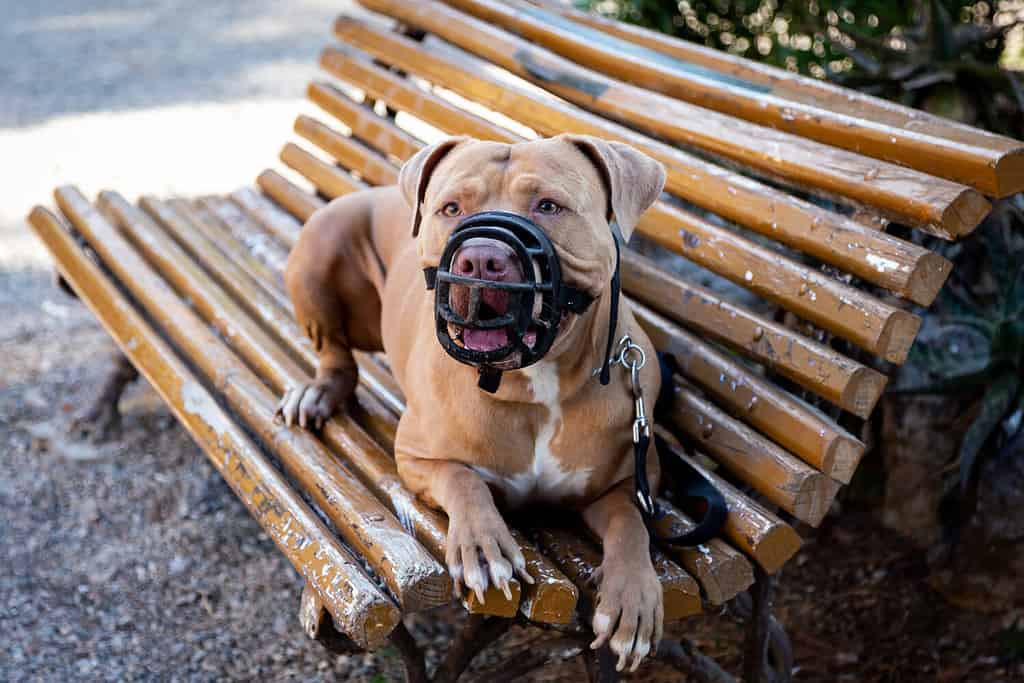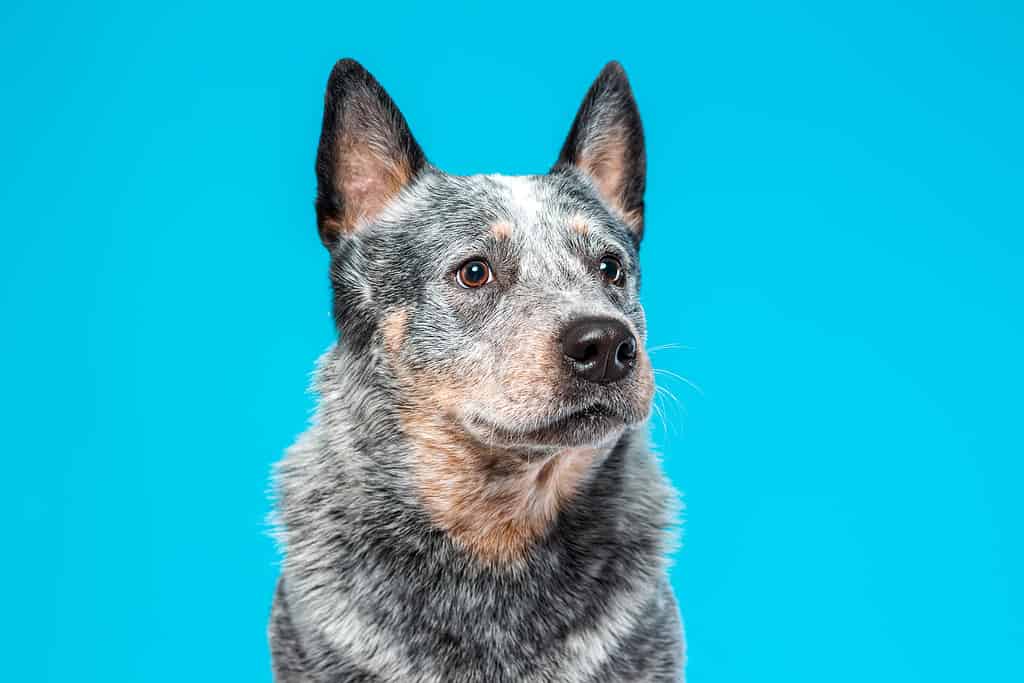A recent study by the American Society for the Prevention of Cruelty to Animals (ASPCA) found that less than half of the animals who enter shelters in a year will get adopted. That’s right — out of 6.5 million animals that enter, only 3.2 get to find their fur-ever homes.
Of the dogs that remain in the shelter, the majority are mixed-breed dogs. However, purebred dogs wind up in shelters too — some breeds more than others. These breeds often end up in
shelters because of abandonment, landlord issues, or owners deciding they’re not a good fit for a family’s home or lifestyle. You can chalk most of these reasons up to irresponsible owners not thinking enough about this life-altering decision.
Below, discover the 17 dog breeds most likely to end up in shelters, designer dog breeds that enter shelters often, and some interesting 2023 shelter statistics.
Pit Bull Terriers

Pit bulls have gotten a rough rap from the 1980s-era dogfighting rings.
©entreguin/Shutterstock.com
While the general term “pit bull” can describe three different breeds, the American Pit Bull terrier ends up in shelters most within the classification, followed closely by American Staffordshire terriers. Thanks to media myths that developed untrue stereotypes, many owners assume their pit bull is overly aggressive as a puppy when they’re learning the ropes of “how to dog.”
“Bully breeds” have had a bad rap for decades, which rescues and shelters have tried to reverse in recent years. The breed is loyal to a fault, which encouraged cruel owners to force the muscular, powerful, and obedient pit bull into dogfighting in the 1980s. After the media caught wind of the stories, the breed retained negative labels like “aggressive” and “scary.”
In reality, pit bulls have some of the best temperaments of all purebred dogs. According to the World Animal Foundation, pit bulls are in the top 25% of best-tempered dogs with an average score of 85% on temperament tests.
Chihuahuas

As cute as chihuahuas are, they have an interesting personality owners need to know how to navigate.
©pjrimages/ via Getty Images
In 2013, would you believe that chihuahuas were the second-most surrendered purebred breed of dog across the nation? The Hollywood hype of chihuahuas — including Paris Hilton’s pup Tinkerbell and movies like the Beverly Hills Chihuahua and Legally Blonde — glamorizes the life and temperament of chihuahuas. Like every dog breed, chihuahuas have a unique disposition that owners need to understand before bringing the pup home. Without proper education, some owners assume their chihuahua is a “lemon” or “just like that.”
Chihuahuas are protective, loyal, and fear-aggressive. They’re commonly referred to as “one-person” dogs because they attach so closely to one family member. They also need consistent, patient training and socialization. This helps to discourage resource guarding of food, people, toys, treats, and spots on the couch. Socialization also ensures chihuahuas can meet new people without snarling, biting, or trying to lash at the stranger out of fear.
Labrador Retrievers

Some Labrador retrievers don’t get the attention they deserve, which causes anxiety and destruction.
©Caroline Anderson/iStock via Getty Images
The family-favorite Labrador retriever remains one of America’s most popular dog breeds. Why, then, do they consistently show up in shelters across the U.S.? Despite their loveable nature, Labs have high energy levels that many owners fail to recognize. If they don’t get enough exercise, Labs can become destructive — and instead of investing in training, owners decide to give up the dog.
Dr. Paola Cuevas, a veterinary consultant at PetKeen, offered more insight to AZ Animals about the reasons Labradors end up in shelters.
“Unfortunately, many owners purchase puppies based on their looks but fail to research the breeds’ specific needs,” she asserted. “Labs are very energetic dogs that need a lot of daily exercise — and if this is not provided, they usually develop destructive behaviors. When Labs grow from a cute puppy to a larger dog that destroys shoes, furniture, toys, plants, pillows, etc., owners get very frustrated and decide to “let them go.”
German Shepherds

The challenge of training a
German shepherd
may convince owners to surrender them to a shelter.
©Korneeva Kristina/Shutterstock.com
The popular German shepherd — which ranks as the fourth-most popular dog in America as of 2022 — enters shelters at an alarming rate because of overbreeding and irresponsible dog ownership. Dr Bethany Hsia, DVM and co-founder of CodaPet, commented on the few reasons she and her colleagues have seen German shepherds in shelters.
“German Shepherds can be challenging to train and require a lot of exercise and mental stimulation, which can be overwhelming for some owners. As a result, many German Shepherds end up in shelters due to their owners being unable to provide the necessary care and attention.”
German shepherds do need significant mental stimulation and exercise. At a minimum, shepherds should receive at least two hours of exercise a day in addition to mental stimulation (through training, games, or puzzles).
Australian Cattle Dogs

Australian cattle dogs are also called blue heelers.
©Irina Nedikova/ via Getty Images
Shelters report Australian cattle dog residents come to them for a solitary reason: the owner’s lack of understanding of their needs creates a bad fit for the family and dog — and therefore surrenders it.
This beautiful breed with a speckled coat and brown or blue eyes makes families fall in love with their look — but that’s the least important part of this breed. Australian cattle dogs demand exercise and mental stimulation because their energy is off the charts. Originally bred to herd cattle and other farm animals, the Australian cattle dog is usually best suited for very active families or those who live on a lot of land.
Boxers

If they don’t get enough exercise, attention, and mental stimulation, boxers will develop behavioral issues.
©ibanezfilm/Shutterstock.com
Somewhere along the line, a falsehood began that boxers are lazy dogs. Perhaps it’s their slight resemblance to bulldogs. Whatever the reason, owners who surrender their boxers usually do so because they are fully unaware of the energy it takes to keep a boxer healthy and happy.
Boxers need hours of exercise every day. A cooped-up boxer will most likely become destructive and soil their home in some way, especially if they’re left alone for hours at a time. This issue may bring about other situations, like consuming something they’ve destroyed and developing an intestinal blockage.
Because they have high energy and heightened training needs, boxers will end up at shelters when their owners use misinformation to make their decision and later realize they’re not fit to take care of this gorgeous and loveable breed.
Beagles

When beagles don’t get the attention and training they need, they can become destructive.
©LightFieldStudios/iStock via Getty Images
The cuteness of a beagle may undercut the significant resources it takes to care for the breed. However, rescues report several different reasons so many individuals of the breed end up in shelters, including:
- Overbreeding and “backyard breeding” to satisfy seasonal demands.
- Unprepared owners.
- The beagle’s personality traits (high prey drive, food motivation, loud baying/barking).
- Laboratory research.
Beagles can also develop intense separation anxiety which leads to destructive behaviors if they’re kept home alone all day. Finally, unethical or improper breeding (and rearing) land innocent beagles in shelters when holiday demand dies down and breeders still have extra puppies.
Bulldogs

Frenchies end up in the shelter when their vet bills become too much for their family to handle.
©Lionel Nganga/Shutterstock.com
Bulldogs — including the American bulldog, the English bulldog, and even French bulldogs — will end up in shelters for a variety of reasons. The first is their perceived aggression.
Like pit bulls, Rottweilers, and other “bully” breeds, bulldogs received a poor reputation from misinformed media outlets decades ago that affects their standing today. Even Rent.com cites bulldogs as one of the few breeds consistently on the breed restriction lists for apartment and condo complexes.
Bulldog breeds are also brachycephalic, meaning they’re at a much higher risk of developing respiratory or breathing issues within their lifetime. If and when a dog gets sick, some owners can’t handle the veterinary bills and abandon the dog instead.
Dr. Mollie Newton, founder of PetMeTwice, commented specifically on French bulldogs’ health. “They’re adorable and have a unique appeal, but they can have significant health problems due to their breeding. These issues can become costly and not all owners are prepared for that level of commitment.”
American Staffordshire Terriers

AmStaffs have both a high prey drive and high energy.
©Nikola Cedikova/Shutterstock.com
Combine a high prey drive with high energy and you get a whole lot of dog. The American Staffordshire terrier (or AmStaff) also suffers the same negative rap that pit bulls and bulldogs get from decades-old dog fighting rings.
AmStaffs are sweet, smart, and confident dogs that show their families a ton of affection every day. They do have mild mental stimulation and exercise needs, as well as an overprotective nature and loyalty to their family.
Apartment and condo complexes count AmStaffs in the classification of bully breeds and will refuse housing to owners who have one (or multiple) in their household.
Border Collies

The
border collie
requires ample training and a mutually-respectful owner relationship.
©xkunclova/Shutterstock.com
As some of the other high-energy dogs on this list have shown, first-time pet parents tend to bite off more than they can chew when they pick a dog based on cuteness, not personality. The border collie is a perfect example of this.
Energetic to the point of downright hyperactivity, border collies need a secure yard and a dedicated family to help them get their “zoomies” out daily. When border collies don’t get the chance to run and exert themselves, they’ll channel their energy into mass destruction in the home.
This eventuality, borne of an owner’s lack of education, sadly surrenders the happy, fun-loving border collie to shelters in droves.
Golden Retriever

Some goldens have too much energy for families and owners take them to the shelter to find a better home.
©Olha Didenko/Shutterstock.com
While golden retrievers are great with families and kids, it takes a significant amount of effort and training to create this disposition. A poorly-trained golden retriever can become destructive or exhibit behavior problems. In turn, the owner chooses to surrender the golden retriever instead of doubling down and training at length to achieve a happy life for both them and their dog.
Goldens also need consistent, daily exercise to stay healthy.
Dachshunds

Owners turn their Dachshunds over to the shelter based on health issues and behavior issues.
©CBCK-Christine/iStock via Getty Images
When it comes to Dachshunds, shelters usually don’t find many abandoned or stray individuals. Instead, owners will surrender the dogs based on health issues they might develop or behavior the owner didn’t do enough research to expect.
Dachshunds have vivacious personalities. They’re affectionate, good with other dogs, and adaptable to most situations. The breed also barks a lot and brings heightened energy and mental stimulation needs. For owners who hoped for a couch potato dog, they may become disappointed to find out their Dachshund wants to play much more often than they’d expect.
It rings true for all purebred dog breeds, but Dachshunds especially. When adopting a purebred dog, do your research on their temperament and personality to ensure they’ll match your household and lifestyle. Avoid bringing home a pup only to return them to the shelter.
Jack Russell Terriers

Training a
Jack Russell
requires time and a
lotof patience.
©eva_blanco/Shutterstock.com
The spirited Jack Russell is a cute, small breed that may seem like a fun adventure to first-time dog owners. However, these dogs have significant demands for attention and exercise, quickly overwhelming inexperienced (and some experienced) dog owners.
Jack Russells will end up in shelters when their families cannot keep up with their training or exercise needs. This places the Jack Russell — who needs consistent exercise — in a stressful, unhappy situation and takes away both their socialization and ability to run.
Shih Tzu

Some shih tzus lose their home with their loved ones and live in a shelter until they find their next fur-ever family.
©Drazen Zigic/Shutterstock.com
The shih tzu remains a popular dog throughout the world — but increased popularity also means an increased risk of ending up in the shelter, just like the Labrador retriever.
When shih tzus end up in shelters, the main reason centers on owner negligence. Though the breed only grows to 16 pounds at most, the shih tzu has long hair and an energetic personality. Older adults and seniors who used to diligently groom their dogs may struggle as time wanes. Conversely, this breed may get left behind to an unwilling family or friend when the owner passes away.
Rottweiler

The big-muscled
Rottweiler
ends up in shelters for multiple reasons.
©Serova_Ekaterina/Shutterstock.com
Because the massive Rottweiler has enough power to take down an adult if instructed, Rotties need a firm training hand from birth. They’re devoted, good-natured dogs who receive a bad reputation because of their appearance and historic use as “vicious” guard dogs. Outside of myths, Rottweilers will protect their families but don’t show outward signs of aggression daily. The American Kennel Club asserts the breed is playful, adaptable, and happy to play with young children.
Rottweilers also consistently show up on the list of breed restrictions for housing complexes alongside German shepherds, mastiffs, pit bulls, bulldogs, and Dobermans.
Siberian Husky

The energy of a
Siberian husky
may overwhelm new dog owners.
©iStock.com/Elayne Massaini
According to Rocky Kanaka, a pet rescue advocate and TV host, the number of Siberian huskies in shelters in 2023 has doubled since 2020. Like other breeds on this list, huskies have a striking appearance — and have stood in the Hollywood spotlight more than once. With superficial popularity comes a misunderstanding of the breed’s true nature: high energy, vocal, independent, and intelligent.
Huskies need consistent, patient training for months as a puppy to become a well-behaved dog. Owners who don’t educate themselves on the training, exercise, and nutrition needs of a husky can quickly become overwhelmed.
Doberman Pinschers

Dobermans need training and a firm hand to grow up well-behaved.
©Fotoarta/iStock via Getty Images
While you’ll see fewer Doberman pinschers in a shelter than you would a pit bull or chihuahua, the breed does end up in shelters more than many other dogs. Some reasons leading to Dobes getting surrendered include a bad reputation, lack of training, and owner relocation.
A Doberman’s protective traits make great owner families feel safe and supported, but some adopters who don’t realize this hallmark of the breed get scared by the “aggression” shown by their dog when they’re defending their home. Dobermans remain powerful, intelligent, and agile dogs with athleticism to spare. They need exercise and training to become well-socialized and well-behaved dogs.
Owners who don’t understand the personality traits and training needs of their Doberman may surrender their dog to the shelter, or simply abandon it because they no longer want to care for the dog. Less frequently, shelters will receive Dobermans due to owner relocations to apartments or housing complexes that have breed restrictions against Doberman pinschers.
Designer Dog Breeds that End Up in Shelters Most

Designer breeds like
goldendoodles
are coveted for their appearance/
©Tanya Consaul Photography/Shutterstock.com
According to the experts that AZ Animals interviewed, several designer dog breeds top the charts of shelter dogs. Designer dog breeds — a mixture of two purebred breeds, like a Golden retriever and poodle for a “goldendoodle — remain popular for their appearance. However, some families and adopters fail to realize the breed’s training, grooming, and exercise needs.
Hana, an expert at PomeraniansCare, informed AZ Animals that poodle mixes end up in shelters in higher percentages than other designer breeds.
“Designer dog breeds that most end up in shelters are poodle mixes [like] labradoodles, goldendoodles, [and] cockapoos). It’s mostly because they are adopted by busy owners who are not ready for their high energy levels. Also, we are all aware that many people buy them only because of their popularity,” Hana continued. “Usually, they are unprepared to actually take care of the dog and that results in more poodle designer mixes ending up in shelters.”
Dr. Newton agreed, stating that “Breeds like labradoodles, goldendoodles, and other “doodle” mixes are often surrendered to shelters. These breeds are popular for their hypoallergenic coats and friendly demeanor, but many people underestimate the care they require. They need regular grooming and exercise, and without it, they can develop behavioral and health issues.”
First-Time Owner Woes
Finally, certified dog trainer and founder of Mindful Doggo Jackie Carleen mentioned labradoodles as one of the top designer breeds in shelters. “They can be the victims of rehoming and end up in a shelter because of their high energy needs. They require a lot of exercise, mental stimulation, and can be some strong pullers on walks.”
In Carleen’s experience, first-time dog owners don’t realize what they’ve gotten themselves into with a labradoodle and fail to complete the proper training. “I’ve seen many labradoodles suffer from anxiety which can manifest with destructive behavior at home that is hard for a first-time dog owner to handle. With training, labradoodles are amazing companions with sweet personalities.”
All the veterinarians and behaviorists AZ Animals interviewed noted that “whenever we speak about the genetics of a breed in this sense it is a generalization, and these broad and sweeping statements are always subject to exceptions especially as it relates on the individual level.”
Canine Shelter Statistics for 2023
- According to data from Shelter Animals Count, post-pandemic euthanasia rates for shelter pets across the country stand to hit a three-year high of 9.5%.
- The same database released information that across the country, shelters had to euthanize 51,000 dogs between January and July 2023 alone.
- The ASPCA recently released a dataset that indicates a lack of human resources is the top barrier to meeting the nonprofit’s mission. This includes a lack of staffing, fosters, and volunteer support.
- The World Animal Foundation conducted a review of studies and research from the last five years and came to the table with some disturbing statistics, including that 52% of animal shelters in the U.S. are kill shelters.
- The five U.S. states involved in euthanizing about 50% of the shelter dogs and cats in the country are California, Texas, North Carolina, Florida, and Louisiana.
Out of Shelters and into Fur-ever Homes
Caring for a dog (or multiple) is a privilege. Before you adopt a dog, make sure you’re ready for the commitment. As Dr. Newton suggests, “It’s vital to fully understand the needs and potential health issues of the breed you’re considering.”
Similarly, consider visiting your local animal shelter before buying from a purebred or designer breeder. Adopting, not shopping, will help to clear the shelters and ensure every dog gets a loving, warm, and wonderful home of family members who care.
The photo featured at the top of this post is © Hannah Carl/Shutterstock.com
Ready to discover the top 10 cutest dog breeds in the entire world?
How about the fastest dogs, the largest dogs and those that are -- quite frankly -- just the kindest dogs on the planet? Each day, AZ Animals sends out lists just like this to our thousands of email subscribers. And the best part? It's FREE. Join today by entering your email below.
Thank you for reading! Have some feedback for us? Contact the AZ Animals editorial team.






